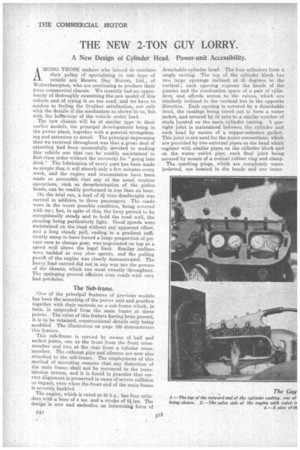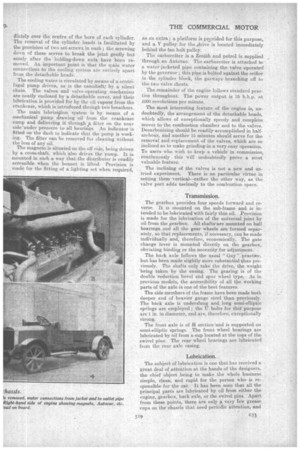THE NEW 2-TON GUY LORRY.
Page 12

Page 13

Page 14

If you've noticed an error in this article please click here to report it so we can fix it.
A New Design of Cylinder Head. Power-unit Accessibility.
A.MONG THOSE makers who intend to continue their policy of specializing in one type of vehicle are Messrs. Guy Motors, Ltd., of Wolverhampton, who are continuing to produce their 2-ton commercial chassis. We recently had an opportunity of thoroughly examining the new model of this vehicle and of trying it on the road, and we have to ,confess to feeling the liveliest satisfaction, not only with the details of the mechanism as shown to us, but with the belraviour of the vehicle under load.
The new chassis will be of similar type to their earlier models, the principal developments being in the power plant, together with a general strengthening and attention to detail. The principal impression that we received throughout was that a great deal of attention had been successfully devoted to making this vehicle one that can be readily maintained in • first-class order without the necessity for "going into dock." The lubrication of every part has been made so simple that it will absorb only a few minutes every week, and the engine and transmission have been made so accessible that any of the usual routine operations, such, as decarbonization of the piston heads, can be readily performed in less than an hour. On the trial run, a load of 21 tons deadweight was carried in addition to three passenger& The roads were in the worst possible condition, being covered with ice; but, in spite of this, the lorry proved to be exceptionally steady and to hold the road well, the steering being particularly light. Good speeds were maintained on the road without any apparent effort, and a long steady pull, ending in a gradient sufficiently steep to have forced a large proportion of private cars to change gear, was negotiated on top at a speed well above the legal limit. Similar inclines were tackled at very slow speeds, and the pulling powe'r of the engine was clearly demonstrated. The heavy load carried did not in any way tax the powers of the chassis, which ran most sweetly throughout. The, springing proved efficient over roads with very bad pot-holes.
The Sub-frame.
' One of the principal features of previous models has been the mounting of the power unit and gearbox together with their controls on a sub-frame which, in turn, is suspended from the main frame at three points. The value of this feature having been proved, it is to be retained, constructional details only being modified. The illustration on page 520 demonstrates this feature.
This sub-frame is carried by means of ball and socket joints, one at the front from the front crossmember and two at the rear from a tubular cross"member. The exhaust pipe and silencer are now also attached to the sub-frame. The employment of this method of mounting ensures that any distortion of the main frame shall not be conveyed to the transmission system, and it is found in practice that correct alignment is preserved in cases of severe collision or impact, even when the front end of the main frame is severely buckled.
The engine, which is rated at 25 b.p., has four cylinders with a bore of 4 ins, and a stroke of si ins. The design is new and embodies an interesting form of detachable cylinder head. The four cylinders form a single casting. The top of the cylinder block has two large openings inclined at 45 degrees to the vertical ; each opening exposes the heads of the pistons and the combustion space of a pair of cylinders, and affordsaccess to the valves, which are similarly inclined to the vertical but in the opposite direction. Each opening is covered by a detachable head, the castings being cored out to form a water jacket, and secured by 12 nuts to a similar number of studs located on the main cylinder casting. A gastight joint is maintained between the cylinder and each head by means of a copper-asbestos gasket. This joint is not used for the water connections, which are provided by two external pipes on the head which -register with similar pipes on the cylinder block and on the water outlet pipe, each final joint being secured by means of a conical rubber ring and clamp. The sparking plugs, which are completely water jacketed, are located in the heads and are imme diately over the centre of the bore of each cylinder. The removal of the , cylinder heads is facilitated by the provision of two set-screws in each ; the screwing down of these serves to break the joint gently but surely after the holding-down nuts have been removed. An important point is that the main water connections to the cooling system are entirely apart from the detachable heads.
The cooling water is circulated by means of a centrifugal pump driven, as is the camshaft; by a silent chain. The valves and valve-operating mechanism • are neatly enclosed by a detachable cover, and their lubrication is provided for by the oil vapour from the crankcase, which is introduced through two breathers.
The main lubricapion system is by Means_ of a, mechanical pump drawing oil from the crankcase sump and delivering it through a filter on the near side 'under pressure to all bearings. An indicator is fitted on the dash to indicate that the pump is working. The filter can be removed for cleaning without the loss of any oil. The magneto is situated on the off side, being driven by a cross-shaft, which also drives the .pump. It is mounted in such a way that the distributer is readily aceessible when the bonnet is lifted. Provision is made for the fitting of a lighting set When required, as an extra ; a, platform is provided for this purpose, • and a, V pulley. for the .alrive is located immediately behind the fan belt pulley.
The carburetter is a Zenith and petrol is supplied through an Autovae. The carburetter is attached to a water-jacketed pipe containing the valve operated by the governor ; this pipe is bolted against the orifice in the cylinder block, the gasways branching off to the two valve chests.
The remainder of the engine follows standard practice throughout. The power output is 35 b.h.p. at 1000 revolutions per minute.
The most interesting feature of the engine is undoubtedly, the arrangement of the detachable heads, which allows of exceptionally speedy and complete access to the combustion chamber and to the valves. Decarbonizing should be readily-accomplished in halfan-hour, and another 15 minutes should serve for the removal and' replacement of the valves, which are so inclined as to make grinding-in a very easy operation. To users who wish to keep a vehicle in commission, continuously this will undoubtedly prove a most valuable feature.
The inclining of the valves is not a new and untried experiment. There is no particular virtue in setting them vertical—rather the other way, as the valve' port adds uselessly to the combustion space.
Transmission. •
• The gearbox provides four speeds forward and reverse. It is .mounted on the sub-frame and is intended to be lubricated with fairly thin oil. Provision is made for the lubrication of the universal joint by oil from the gearbox. All she mounted on ball bearings and all the gear wheels are formed separately, so that replacements, if necessary, can be made individually and; therefore,, economically. The gate change lever is mounted directly on. the gearbox, obviating binding or the necessity for adjustment.
The back axle follows the usual " Guy ".. practice, but has been made slightly more substantial than previously. The shafts only take the drive, the weight 'being taken by the casing. The gearing is of the double. reduction bevel and spur wheel type. As in previous models,, the accessibility of all the working parts of the axle is one of the best features.
The side members of the frame have been made both deeper and of heavier gauge steel than previously. The back axle is underslung and,, long springs are employed ; the U bolts for this purpose are 1 in. in diameter, and are, therefore, exceptionally strong.
The front axle is of H section rand is supported on semi-elliptic springs. The front wheel bearings are lubricated by oil from a cup located at the tops of the swivel pins. The rear -wheel bearings are lnbricated from the rear axle easing.
Lubrication.
The subject pf lubrication is one that has received a great deal of attention at the hands of the designers, the chief object .being to make the whole business simple, clean, and rapid for the person whola responsible for the car. It has been seen that all the principal parts are lubricated by oil from either the engine, gearbox, back axle, or the swivel pins. Apart from these points, there are only a -very few grease cups on the chassis that need periodic attention, and
these have been located so that they are readily accessible. Small oil cups or oil holes are completely dispensed with.
A governor determining the maximum speed of the vehicle is located next to the forward universal joint, and is enclosed so that it cannot readily be tampered with ; it takes effect upon a valve in the induction pipe. Theradiator is of the vertical tube type with detachable top and bottom tanks. Although a. pump is provided, the cooling system is designed so as to work on thermosyphon lines as well. The foot-operated brake acts on the bevel pinion . shaft and the 'operating mechanism contains a spring device to avoid harsh action . through the carelessness of the driver. The hand brakes act on drums on the back wheels.
The steering is of the worm-andsector type and the rake of the steering wheel can be altered as desired.
Dunlop tyres of the solid band type are standardized 720 by 100 single being fitted on the front wheels and the same size but twin being fitted on the rear. The whole chassis gives the impression of being well up to its work and of being capable of carrying much greater loads than its normal capacity ; at the same time the weight is not high, about 35 cwt. unladen, and we are assured that under normal conditions and on reasonable roads the consumption will be about 12 miles per gallon when loaded.
The price of the standard chassis has teen discussed, but at the time of going to press is not finally decided.
The wheelbase of the 2-ton Guy is .12 ft., the overall length 17 ft. 4 ins., the overall width 6 ft. 2 ins., the body space 12 ft. 4 ins, from the rear of dashboard to end of frame, the track 5 ft. and the clearance 10 ins.






















